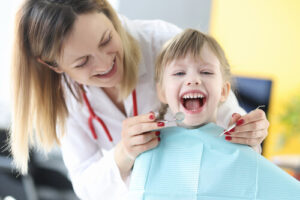Pediatric Dental Sedation: Navigating Through the Nuances of Child-Friendly Dentistry

Navigating the crucial topic of pediatric dental sedation, we find ourselves amidst a confluence of care and innovation in children’s dentistry. How do dental professionals curate a realm of comfort and safety tailored for our young ones during their essential dental treatments? The pursuit of understanding and implementing pediatric dental sedation is not just a medical journey but an exploration into alleviating the anxieties and concerns of both parent and child.
This guide aims to unravel the intricate layers, debunk myths, and provide clear insights into sedation’s pivotal role in pediatric dental practice, types of sedation, and its side effects to ensure your child’s journey is as smooth and worry-free as possible.
Types of Sedation that pediatric dentists use for diagnostic and therapeutic procedures
Ensuring a child’s comfort, safety, and cooperation during diagnostic and therapeutic procedures is paramount in pediatric dentistry. As such, pediatric dental professionals have, over the years, adopted a range of sedation methods tailored to meet young patients’ unique needs and temperaments. These sedation methods alleviate anxiety and ensure that treatments are carried out effectively and safely.
1. Nitrous Oxide Sedation (Laughing Gas): One of the most common sedation techniques, nitrous oxide sedation is a mild sedative. Administered through a mask placed over the nose, the gas or laughing allows children to relax without putting them to sleep. The effects wear off soon after the mask is removed, making it a favored option for its immediacy.
2. Oral Sedatives: Given in the form of a liquid or pill, these sedatives help children relax or doze off during a procedure. Though the sedation may not be as profound as other sedation forms, oral sedatives require monitoring of the child’s vital signs during the procedure.
3. IV Sedation: Administered directly into the bloodstream through an intravenous line, IV sedation offers a deeper sedative effect. Its dosage can be adjusted as needed, allowing the dentist to perform longer procedures while ensuring the whole child remains awake and calm.
4. General Anesthesia: Reserved for extensive treatments or for children who cannot cooperate due to age or certain conditions, general anesthesia renders the patient fully unconscious. This method requires a specialized anesthesiologist to be present during the procedure.
5. Local Anesthetics: While not sedatives in the traditional sense, local anesthetics like lidocaine are the drugs used to numb specific areas in the mouth, ensuring pain-free dental procedure.
Pediatric dentists are armed with a versatile toolkit of sedation methods, each meticulously designed to cater to different procedures and patient needs. By integrating these techniques, dentists can ensure that every young patient receives the necessary care in a setting of utmost comfort and safety.
Pediatric dental sedation guidelines

The meticulous and thoughtful application of pediatric dental sedation guidelines is imperative in safeguarding young patients undergoing various dental procedures. As pediatric dental treatments often entail specific challenges, such as managing anxiety and ensuring cooperation, these various procedural sedation guidelines are instrumental in defining the prudent use of sedative agents, ensuring safety and efficacy during dental treatments.
Adherence to Professional Guidelines Under
the umbrella of pediatric dental sedation guidelines, adherence to recommendations from reputable bodies, such as the American Academy of Pediatrics and other pediatric dental associations, is crucial. These organizations delineate crucial aspects like determining the appropriate level of sedation, patient evaluation, and requisite facilities, promoting safe and effective pediatric sedation.
Identifying Suitable Sedation Methods
Accurately determining the types of sedation to be employed forms the backbone of these guidelines, from mild sedation involving nitrous oxide for sedation to moderate sedation employing oral sedation and, in more intensive cases, deep sedation or general anesthesia.
Dentists must meticulously evaluate and select the most appropriate method, considering the procedure’s nature and the child’s disposition. Detailed evaluation of these sedation types’ side effects and a thorough understanding of dental sedation procedures are imperative to ensure optimal patient care.
Patient Evaluation and Monitoring
It is paramount to ensure a comprehensive pre-sedation evaluation of pediatric patients, encompassing their medical history, current health status, and psychological disposition toward dental treatment.
Continuous monitoring during the dental procedure and a short-term structured recovery phase, including specific discharge criteria, are pivotal elements of the guidelines. Special attention must be directed towards patients undergoing procedures involving intravenous (IV) sedation or those requiring intravenous sedation for complex or extended procedures.
Parental Involvement and Communication
Ensuring parents or guardians are intimately involved in the process, from understanding the selected sedation type, such as nitrous oxide gas or an oral sedative, to being familiarized with the pre-procedure requisites and post-procedure care.
This ensures an added layer of safety and compliance. Pediatric dentist communications should transparently convey the risks, benefits, and critical importance of adherence to pre- and post-sedation instructions.
Emergency Preparedness
Given the intrinsic risks associated with sedatives, a robust emergency preparedness plan is integral to pediatric sedation guidelines.
Dental professionals must demonstrate proficiency in managing potential adverse effects or emergencies during sedation. Whether utilizing sedation for dental treatments or more invasive dental surgery, preparedness to manage any unforeseen reactions to the sedative medication is non-negotiable.
Each step, from selecting the appropriate sedation procedure to ensuring a structured recovery, must be navigated with utmost precision and consideration for the child’s wellbeing. Thus, these guidelines act as a beacon of procedural decency and a testament to the unwavering commitment towards safeguarding our young charges amidst the dental interventions they may require.
What is oral conscious sedation for pediatric dentistry

To ensure a calm and stress-free dental experience for young children, oral conscious sedation in pediatric dentistry is a crucial tool in navigating the often challenging terrains of dental procedures.
Characterized by administering sedative drugs through an oral route, pediatric conscious sedation has been notably utilized to mitigate anxiety and facilitate a more manageable and cooperative environment for both the patient and the dental practitioner.
- Anxiety Management: One of the primary objectives of oral conscious sedation is to alleviate dental anxiety among children, ensuring that their experience in the dental chair is comfortable and non-traumatic.
- Maintained Consciousness: Despite the soothing effect, children under oral conscious sedation remain awake and capable of responding to stimuli or directions from the dentist, marrying tranquility with cooperative responsiveness.
- Safety and Effectiveness: Adhering to proper guidelines and utilizing predetermined dosages ensures that oral conscious sedation is both safe and effective, allowing for the successful execution of dental procedures without distress to the young patient.
- Wide Applicability: Oral conscious sedation can be effectively applied across various dental procedures, from basic interventions like cleanings to more intricate procedures, acting as a versatile agent in managing patient demeanor and compliance.
- Post-Procedure Amnesia: A noteworthy feature of oral conscious sedation is the potential for post-procedure amnesia, where the child may have little to no memory of the events during the dental treatment, further safeguarding against potential dental phobias.
- Parental Reassurance: For parents, knowing their child is free from anxiety and discomfort during dental procedures provides vital reassurance, establishing a foundation of trust between the parent, child, and dental practitioner.
Integrating oral conscious sedation into pediatric dentistry ensures smoother procedural dental workflows. It prioritizes the child’s emotional and psychological wellbeing, fostering a positive and constructive relationship with dental care that could invariably benefit them in their adult lives. This methodology, rooted in the compassionate approach toward pediatric dental care, validates the emphasis on creating a gentle and empathetic dental journey for our youngest patients.
What are the side effects of conscious sedation in pediatric dentistry?
Navigating the delicate complexities of conscious sedation in pediatric dentistry, it becomes paramount to understand its ramifications, particularly the side effects it may potentiate.
While conscious sedation is a cornerstone in mitigating anxiety and fostering a cooperative environment in pediatric dental care, it is not devoid of potential side effects.
Parents, guardians, and caregivers should know these possible side effects to make informed and cautious decisions about their child’s dental care.
- Drowsiness: Even after the procedure, the sedative’s effect might linger, causing prolonged drowsiness and requiring close observation until full alertness is regained.
- Nausea and Vomiting: Some children might experience nausea or vomiting post-sedation, which may be unsettling and necessitates appropriate aftercare and monitoring.
- Dizziness: A feeling of imbalance or dizziness is plausible, demanding careful assistance and supervision to avert falls or injuries.
- Altered Coordination: Impaired motor coordination may persist for a few hours post-sedation, necessitating a secure environment to prevent accidental harm.
- Delayed Reflexes: The retardation of reflex responses can be a temporary aftermath, warranting vigilant supervision, particularly in interactions with objects or while navigating through spaces.
- Mood Fluctuations: Alterations in mood or emotional state might surface, ranging from euphoria to irritability, requiring a calm and reassuring presence.
- Residual Confusion: Temporary confusion or disorientation might be encountered immediately after the sedation.
The amalgamation of meticulous professional oversight during the procedure and vigilant aftercare by guardians ensures that the child traverses through the dental experience with minimized discomfort and maximized safety. Thus, it remains incumbent upon dental professionals to judiciously disseminate this information, empowering parents and caregivers in their roles and instilling confidence in the collaborative journey of maintaining pediatric oral health.
Do kids need to be sedated for tooth extraction?
Sedation for tooth extractions in children is not universally required but can be particularly helpful in managing potential anxiety or fear. The decision to employ sedation is customarily tailored to the child’s needs, considering factors like the procedure’s complexity, emotional state, and overall health.
Pediatric dentists, with expertise in child-specific sedation, assess the child’s dental and medical histories, emotional comfort, and cooperation levels to determine if sedation is advisable.
Both parents and dentists aim to ensure the child’s wellbeing and comfort during the procedure, making sedation a valuable tool for facilitating a calm, pain-free experience when necessary.
Is dental sedation safe for children?
Dental sedation is generally considered safe for children when administered by professionals adhering to stringent guidelines. The American Academy of Pediatric Dentistry and the American Academy of Pediatrics provide explicit guidelines and recommendations for pediatric dental sedation, ensuring children’s safety and wellbeing are paramount.
Before sedation, a comprehensive examination and health history review are performed to discern potential risks. Pediatric dentists, extensively trained in child-specific sedation, exercise meticulous caution and typically utilize the least sedation to achieve the desired effect.
Parental understanding and consent, appropriate dosing, and thorough monitoring during the procedure further bolster the safety of dental sedation in the pediatric population.
Conclusion
In sum, pediatric dental sedation is pivotal in ensuring smooth, anxiety-free dental procedures for children, mitigating distress, and enhancing efficiency. Adhering strictly to established guidelines for pediatric procedural sedation ensures safety and fosters a positive initial dental experience, which is crucial for ongoing oral health in youthful patients. Understanding and strategically navigating its application is fundamental to promoting optimal pediatric oral care without the burden of procedural anxiety.
References
Anesthesia or Sedation for Your Child’s Dental Work
https://www.healthychildren.org/English/healthy-living/oral-health/Pages/Anesthesia-or-Sedation-for-Your-Childs-Dental-Work.aspx
Pediatric Dental Sedation: Evolution and Current State-of-the-Art
https://www.ncbi.nlm.nih.gov/pmc/articles/PMC5490120/
Sedation – Children’s Hospital of Pittsburgh
https://www.chp.edu/our-services/dental-services/patient-procedures/sedation
Behavior Guidance for the Pediatric Dental Patient
https://www.aapd.org/globalassets/media/policies_guidelines/bp_behavguide.pdf
Pediatric Dental Sedation Practice: Evolution and Current State-of-the-Art
https://www.researchgate.net/publication/265652255_Pediatric_Dental_Sedation_Practice_Evolution_and_Current_State-of-the-Art


